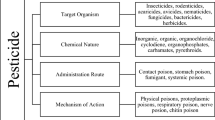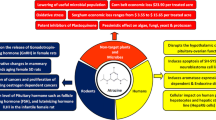Summary
The phase II metabolite of acetaminophen in filamentous fungi and actinomycetes separated from soil was investigated. Fifty-four filamentous fungi and twenty-seven actinomycetes were screened to transform acetaminophen. The metabolites of acetaminophen were assayed using liquid chromatography-tandem mass spectrometry. The only metabolite was subject to enzymatic hydrolysis to confirm its structure. Acetaminophen was converted into glucoside conjugate, by filamentous fungi JX1-60, LN17-2, LN20-1 and the yield of the conjugate was 60.01%, 44.27%, 100%, respectively, and no phase I metabolites were detected. Glucoside conjugation of acetaminophen in filamentous fungi differs from the phase II metabolism of glucuronidation in humans. The fungus LN20-1 could be a suitable model to synthesize glucoside conjugate of acetaminophen.
Similar content being viewed by others
References
Srisilam K., Veeresham C. (2003): Biotransformation of drugs by microbial cultures for predicting mammalian drug metabolism. Biotechnol. Adv., 21, 3–39.
Vereczkey L., Jemnitz K., Gregus Z. (1998): Human drug metabolizing enzymes II- Conjugation enzymes. Acta Pharm. Hung., 68, 284–288.
Hinson J.A., Forkert P.G. (1995): Phase II enzymes and bioactivation. Can. J. Pharmacol., 73, 1407–1413.
Ritter J.K. (2000): Roles of glucuronidation and UDP-glucuronosyl transferases in xenobiotic bioactivation reactions. Chem. Bio. Interact., 129, 171–193.
Zhang D., Yang Y., Leakey J.E., Cerniglia C.E. (1996): Phase I and Phase II enzymes produced by Cunninghamella elegans for the metabolism of xenobiotics. FEMS. Microbiol. Lett., 138, 221–226.
Wackett L.P., Gibson D.T. (1982): Metabolism of xenobiotic compounds by enzymes in cell extracts of the fungus Cunninghamella elegans. Biochem. J., 205, 117–122.
Grace S.N.L., Critchley J.A.J.H. (1994): The estimation of paracetamol and its major metabolites in both Plasma and urine by a single high-performance liquid chromatography assay. J. Pharm. Biomed. Anal., 12, 1563–1572.
Pabba S.K., Bolla S., Kandhagatla R., Chaluradi M.R., Krishna D.R. (2002): Paracetamol metabolism in Indian population. Arzneimittel-Forsch., 52, 769–772.
Kirkman S.K., Zhang M.Y., Horwatt P.M., Scatina J. (1998): Isolation and identification of bromfenac glucoside from rat bile. Drug Metab. Dispos., 26, 720–723.
Chen X.Y., Zhao L.M., Zhong D.F. (2003): A novel metabolic pathway of morphine: formation of morphine glucosides in cancer patients. Br. J. Clin. Pharmacol., 55, 570–578.
Pothuluri J.V., Evans F.E., Heinze T.M., Cerniglia C.E. (1996): Formation of sulfate and glucoside conjugates of benzole] pyrene by Cunninghamella elegans. Appl. Microbiol. Biotechnol., 45, 677–683.
Ye M., Qu G., Guo H., Guo D. (2004): Specific 12 bete-hydroxylation of cinobufagin by filamentous fungi. Appl. Environ. Microbiol., 70, 3521–3527.
Azerad R. (1999): Microbial models for drug metabolism. Adu. Biochem. Eng. Biotech., 63, 169–218.
Huang H.H., Ma G.L., Sun Y.M., Li Q., Zhong D.F. (2005): Phases II metabolites of etofesalamide in filamentous fungi. Acta Pharm. Sin., 26, 893–896.
Ma G.L., Huang H.H., Sun Y.M., Zhong D.F. (2004): Study on the phase II metabolites of the osalmide transformed by filamentous fungi. J. Shenyang Pharm. Univ., 21, 141–144.
Xie Z.Y., Huang H.H., Zhong D.F. (2005): Biotransformation of pantoprazole by the fungus Cunninghamella blakesleeana. Xenobiotica, 35, 467–477.
Bouktaib M., Atmani A., Rolando C. (2002): Regio- and stereoselective synthesis of the major metabolite of quercetin, quercetin-3-O-b-D-glucuronide. Tetrahedron Lett., 43, 6263–6266.
Melvin F., McNeill A., Henderson P.J.F., Herbert R.B. (1999): The improved synthesis of b-D-glucuronides using TEMPO and t-butyl hypochlorite. Tetrahedron Lett., 40, 1201–1202.
Author information
Authors and Affiliations
Rights and permissions
About this article
Cite this article
Huang, H.H., Lin, L.H., Zhang, P. et al. Formation of glucoside conjugate of acetaminophen by fungi separated from soil. European Journal of Drug Metabolism and Pharmacokinetics 31, 103–108 (2006). https://doi.org/10.1007/BF03191126
Received:
Issue Date:
DOI: https://doi.org/10.1007/BF03191126




